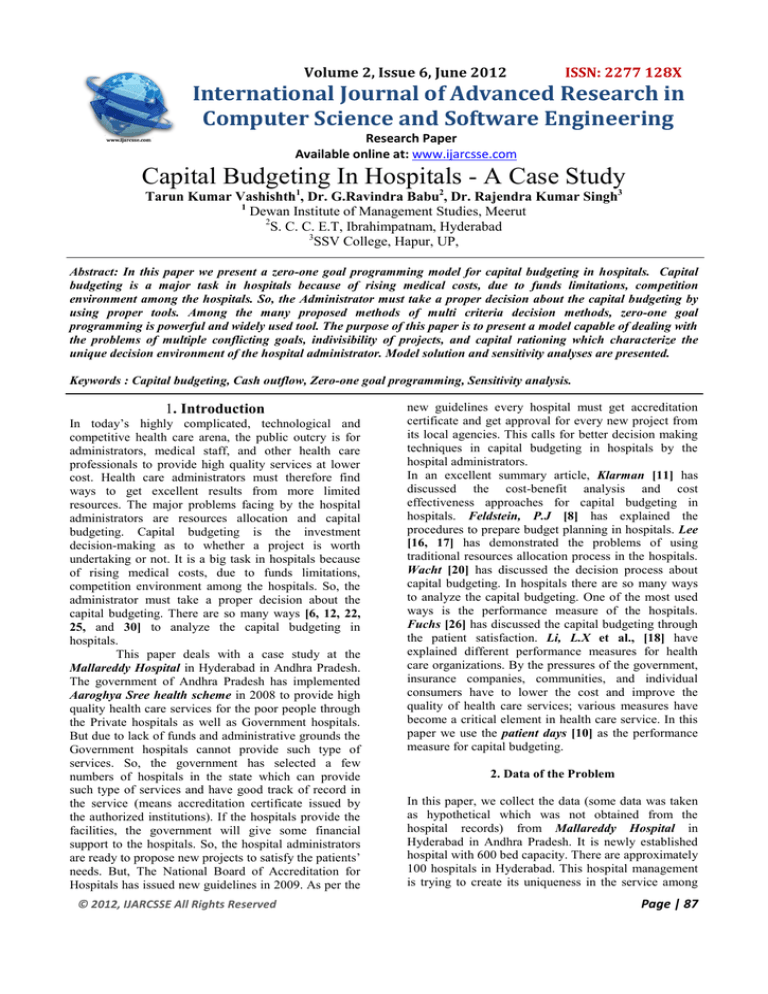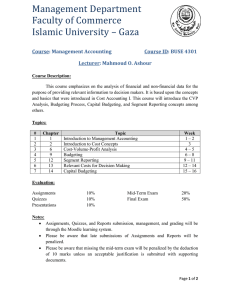
Volume 2, Issue 6, June 2012
ISSN: 2277 128X
International Journal of Advanced Research in
Computer Science and Software Engineering
Research Paper
Available online at: www.ijarcsse.com
Capital Budgeting In Hospitals - A Case Study
Tarun Kumar Vashishth1, Dr. G.Ravindra Babu2, Dr. Rajendra Kumar Singh3
1
Dewan Institute of Management Studies, Meerut
2
S. C. C. E.T, Ibrahimpatnam, Hyderabad
3
SSV College, Hapur, UP,
Abstract: In this paper we present a zero-one goal programming model for capital budgeting in hospitals. Capital
budgeting is a major task in hospitals because of rising medical costs, due to funds limitations, competition
environment among the hospitals. So, the Administrator must take a proper decision about the capital budgeting by
using proper tools. Among the many proposed methods of multi criteria decision methods, zero-one goal
programming is powerful and widely used tool. The purpose of this paper is to present a model capable of dealing with
the problems of multiple conflicting goals, indivisibility of projects, and capital rationing which characterize the
unique decision environment of the hospital administrator. Model solution and sensitivity analyses are presented.
Keywords : Capital budgeting, Cash outflow, Zero-one goal programming, Sensitivity analysis.
1. Introduction
In today’s highly complicated, technological and
competitive health care arena, the public outcry is for
administrators, medical staff, and other health care
professionals to provide high quality services at lower
cost. Health care administrators must therefore find
ways to get excellent results from more limited
resources. The major problems facing by the hospital
administrators are resources allocation and capital
budgeting. Capital budgeting is the investment
decision-making as to whether a project is worth
undertaking or not. It is a big task in hospitals because
of rising medical costs, due to funds limitations,
competition environment among the hospitals. So, the
administrator must take a proper decision about the
capital budgeting. There are so many ways [6, 12, 22,
25, and 30] to analyze the capital budgeting in
hospitals.
This paper deals with a case study at the
Mallareddy Hospital in Hyderabad in Andhra Pradesh.
The government of Andhra Pradesh has implemented
Aaroghya Sree health scheme in 2008 to provide high
quality health care services for the poor people through
the Private hospitals as well as Government hospitals.
But due to lack of funds and administrative grounds the
Government hospitals cannot provide such type of
services. So, the government has selected a few
numbers of hospitals in the state which can provide
such type of services and have good track of record in
the service (means accreditation certificate issued by
the authorized institutions). If the hospitals provide the
facilities, the government will give some financial
support to the hospitals. So, the hospital administrators
are ready to propose new projects to satisfy the patients’
needs. But, The National Board of Accreditation for
Hospitals has issued new guidelines in 2009. As per the
© 2012, IJARCSSE All Rights Reserved
new guidelines every hospital must get accreditation
certificate and get approval for every new project from
its local agencies. This calls for better decision making
techniques in capital budgeting in hospitals by the
hospital administrators.
In an excellent summary article, Klarman [11] has
discussed the cost-benefit analysis and cost
effectiveness approaches for capital budgeting in
hospitals. Feldstein, P.J [8] has explained the
procedures to prepare budget planning in hospitals. Lee
[16, 17] has demonstrated the problems of using
traditional resources allocation process in the hospitals.
Wacht [20] has discussed the decision process about
capital budgeting. In hospitals there are so many ways
to analyze the capital budgeting. One of the most used
ways is the performance measure of the hospitals.
Fuchs [26] has discussed the capital budgeting through
the patient satisfaction. Li, L.X et al., [18] have
explained different performance measures for health
care organizations. By the pressures of the government,
insurance companies, communities, and individual
consumers have to lower the cost and improve the
quality of health care services; various measures have
become a critical element in health care service. In this
paper we use the patient days [10] as the performance
measure for capital budgeting.
2. Data of the Problem
In this paper, we collect the data (some data was taken
as hypothetical which was not obtained from the
hospital records) from Mallareddy Hospital in
Hyderabad in Andhra Pradesh. It is newly established
hospital with 600 bed capacity. There are approximately
100 hospitals in Hyderabad. This hospital management
is trying to create its uniqueness in the service among
Page | 87
Volume 2, Issue 6, June 2012
www.ijarcsse.com
the already established hospitals. The following Table-1
shows the various projects and corresponding cash out
flows, the patient days in blood area, neurology area,
Blood
(Pd’s)
COF(Rs)
Project details
Portable X-ray
machine X1
ECG machine X2
X-ray view box X3
Pulse oxy meter X4
OT table X5
Nebulizer X6
Defibulator X7
Incubator X8
Bennet respiratory
machine X9
Automated chemistry
analyzer X10
Coulter-s analyzer X11
Blood gas analyzer X12
Ultra sonography X13
Multi para monitor X14
C-arms X15
Slit lamp X16
Micro scope X17
Anesthesia machine X18
2Decho X19
laparoscope X20
3,00,000
1,00,000
1,50,000
5,00,000
15,00,000
1,50,000
5,00,000
3,50,000
cancer area, respiratory area, orthopedic area, and
coronary area.
Table-1
Neurology Cancer
(Pd’s)
(Pd’s)
30
70
32
10
40
Respiratory
(Pd’s)
Orthopedic
(Pd’s)
Coronary
(Pd’s)
20
25
34
62
10
110
30
16
25
10
70
55
55
20
35
65
110
4,30,000
90
11,00,000
80
10
8,00,000
12,00,000
15,00,000
4,00,000
15,00,000
3,25,000
2,00,000
15,00,000
20,00,000
20,00,000
75
92
10
10
15
8
20
30
40
5
7
10
25
60
75
10
25
10
13
16
90
20
10
25
20
65
9
26
35
70
7
17
30
60
9
55
10
30
9
110
30
10
4
9
25
10
30
3. Research Methodology
The multi criteria decision-making model (MCDM) is
defined as a mathematical model for decision process
that allows the decision maker to assess a variety of
competing alternatives to achieve asset of goals. One of
the most widely used MCDM models is goal
programming (GP) model. GP is a more powerful
technique than the linear programming (LP), since it
can handle multiple objectives as well as a single
objective [3, 27]. The major difference between LP and
GP is that the GP model does not optimize the objective
directly, as in the case of LP. Instead, it attempts to
minimize the deviations between the desired goals and
the realized results. Also, these goals must be
prioritized in a hierarchy of importance. Deviational
variables can be positive or negative. A positive
deviation ( d I ) represents overachievement of the goal.
A
negative
deviation
variable
( dI )
represents
underachievement of the goal. By utilizing these
deviational variables, the general GP model can be
defined as follows.
Minimize ∑ WJ PJ ( d I + d I )
© 2012, IJARCSSE All Rights Reserved
Subject to ∑ [AIJ XIJ] +
I
I
I d – I d = BI
Where WJ is the preemptive weight of each priority J,
PJ is the preemptive
priority of goal J
or constraint J, AIJ is the technological coefficient
between decision
variable I and constraint
J, XIJ is the decision variable I on constraint J, d I is
positive deviation
variable, d I is negative deviation variable, and BI is the right-hand- side
value of constraint I.
In the hospital capital budgeting problem, if all the
goals are in profit or utility measurements, a linear
programming model will be appropriate. But it is not
possible in hospital capital budgeting. For example, in a
hospital capital budgeting problem, rupee values
associated with the purchase of ECG machine are
impossible to determine its benefits from reduced
Page | 88
Volume 2, Issue 6, June 2012
www.ijarcsse.com
suffering, increased working days of patients, and
increase in patients’ expected life are to be considered.
Danting[6] and Weingartner.H.M.[27] have suggested
the use goal programming for capital budgeting in
hospitals.
In hospitals some of the projects may be mutually
exclusive and dependent. The ordinary goal
programming requires multiple runs in order to satisfy
mutually exclusive and dependent projects. Moreover,
the problems of indivisibility of projects cannot be
handled with the ordinary goal programming. These
problems can be easily handled by the zero-one goal
programming. The zero-one goal programming is a
powerful tool to find an optimal solution for an
assignment or project selection models in hospitals [6,
12, 22, 25, 30].
In order to provide clarity in the model formulation, we
present a general model before studying a case study.
This goal formulation is just one of many alternative
goal combinations possible.
Xi
= project i expressed by zero-one value (
i=1,2……………..m), where the local
agency approval, if such is required under
the new guideline of NABH, is a prior
condition for consideration.
Xi
= 1 if ith project is accepted
Xi
= 0 if ith project is rejected
COFi = cash outflow associated with project i
CB
= capital budgeting constraint
LDFP = funds legally designated to be spent on
Qip
Qip (p=1…………P)
= a dummy variable and it is equal to 1 when
project Xi is included in the set of projects
on which LDFP must be spent, otherwise 0
Eik
=
improvement in the performance measure
for department k resulting from acceptance
of Project i.
DESk = the desired performance measure improvement
in department k (k=1……..n)
4.1 System and Goal Constraints Formulation
1) If projects i and j are mutually exclusive then the
constraint can be expressed as
Xi + X j ≤ 1
2) If the acceptance of project i is dependent upon the
acceptance of project j. This constraint can be
expressed as X i - X j ≤ 0
m
3) Capital budgeting ceiling goal is
COF
i 1
-
i
+
d
d = CB
Where the d and d are slack variables
(deviations) which in turn are incorporated into the
© 2012, IJARCSSE All Rights Reserved
4) In order to get accreditation by the NABH, it is
necessary to accept at least l projects from the
projects i = 1 to i = m then the constraint is
m
X
i 1
i
+
d - d
= l .This goal can
be sought through the minimization of
negative
deviations
5) Because of some political legal reasons, if the funds
are prior earmarked to be spent on designated
projects, then the constraint is
m
COF
i
i 1
4. Model Formulation
projects Xi
objective function. Thus, the budgeting goal can be
satisfied through the minimization of the positive
deviations.
X i Qip + d - d
= LDFP ( p
=1…………P). This goal can be attained by
minimizing the negative deviations.
6) The improvement in the functional area performance
goal can be expressed as
m
E
i 1
k
i
Xi
+
d - d
= DESk (k=
1………..n). This can be achieved by minimizing
the negative deviations.
4.2 Objective Function
The objective function for the hospital capital budgeting
problem is the minimization of the appropriate
deviations which are weighted and/or ranked in the
manner dictated by the priority structure of the hospital
as determined by hospitals’ management members, the
medical staff and the administrative staff of the hospital
as together or individual.
5. Model Implementation
5.1 System Constraints
Because of the limited space X5 and X19 are mutually
exclusive. This constraint can be expressed as X5 +
X19 ≤1.
The head of the Cardiology department has requested
the administrator that project X2 cannot be accepted
unless the project X7 is also accepted. This constraint
can be expressed as
X2 - X7≤ 0
5.2 Administrative Goals and Priorities
The Mallareddy hospital administration has provided
the following goals in order of their importance.
P 1:
The main important goal of the hospital capital
budgeting is to limit the expenditures to the
budgetary limit of Rs 1, 20, 00,000
P 2:
The second goal is in view of getting the
accreditation of NABH, the hospital must
accept at least five of the following nine
projects X1, X2 , X4 ,X5 ,X8, X11, X13 ,X15, X20
P 3:
The third goal is to assure that at least Rs 30,
00,000 to be spent on the projects X1, X3 X5,
X7,X8,X16, X19 to satisfy the legal constraints
Page | 89
Volume 2, Issue 6, June 2012
www.ijarcsse.com
imposed by prior earmarking of funds both
public and private
P 4:
The fourth goal involves the acceptance of at
least two of the projects from the set of
projects X2, X13, X15, X19 for political and
social reasons
P 5:
The fifth goal is to improve the performance
measure in the coronary area by 400 patient
days
P 6:
The sixth goal is to improve the performance
measure in the neurology area by 250 patient
days
P 7:
The seventh goal is to improve the
performance measure in the blood area by 300
patient days
P 8:
The eighth goal is to improve the performance
measure in the cancer area by 350 patient days
P 9:
The ninth goal is to improve the performance
measure in the respiratory area by 400 patient
days
P10:
The tenth goal is to improve the performance
measure in the orthopedic area by 150 patient
days
A. System Constraints
X5 + X19 + d1
d1 = 1 (mutually exclusive)
-
X2 - X7 + d 2 - d 2
=
0
(mutually
X2+ X13+ X15+ X19 +
F. Improvement in Coronary area Performance
34X1+ 62X2+10 X3+110 X4 +30 X5 + 65X7 +20 X9 +
26X10 +17 X11+30 X12 +60 X13 +
9X14+55 X15 +10 X16 + 30X17+9 X18+ 110X19 +
30X20 +
d 7 - d 7 = 400
G. Improvement in Neurology area Performance
30X1+ 32 X3+40 X5 + 10X10 +15X11+8 X12 +20 X13
+30X14+40 X15 +5 X16 +
H. Improvement in Blood area Performance
110X8+ 80 X10+75X11+92X12 +10 X13 +10X14+10
X16 + 25X17 +
d 9 - d9 =300
I. Improvement in Cancer area Performance
70X1+ 10 X3+55 X5 + 20X7 +25X11+60 X12 +75 X13
+10X14+25 X15 +10 X16 +
13X17+16X18+ 20X20 +
d10 - d10 =350
J. Improvement in Respiratory area Performance
20X1+ 25 X4 +10 X5 + 70X6+55 X7 + 90X9 +65
X10+35 X11 +70 X12 +
4 X14+9 X16 +
d11 - d11 = 400
K. Improvement in Orthopedic area Performance
25X1+ 16X3+35 X5+9 X10+7 X11+ 10X13+25 X15+
d12 - d12 =150
10X16+30 X18+
B. Budget Ceiling Goal
3,00,000X1+ 1,00,000X2+ 1,50,000X3+ 5,00,000X4+
15,00,000X5+1,50,00X6+5,00,000X7 +
3,50,000X8+ 4,30,000X9+ 11,00,000X10+
8,00,000X11+ 12,00,000X12+ 15,00,000X13 +
4,00,000X14+15,00,000X15+ 3,25,000X16+
2,00,000X17+15,00,000 X18+20,00,000 X19 + 20,
L. Objective Function
Minimize = P0 [ d1 + d 2 ] + P1
d3 + P2 d 4 + P3
d 5 + P4 d 6 + P5 d 7 +P6 d8 + P7 d 9
+ P8
d 3 - d3 = 1, 20, 00,000
d10 + P9 d11 + P10 d12
6. Solution and Sensitivity Analysis
C. Accreditation Goal
X1+ X2+ X4 + X5 + X8 + X11 + X13 + X15 + X20 +
d 4 -
d 4 = 5
D. Legal Goal
3,00,000 X1+1,50,000X3+15,00,000 X5+ 5,00,000 X7
+ 3,50,000X8 + 3,25,000X16 + 20,00,000X19 +
d8 - d8 = 250
7X17+10X18+ 90X20 +
dependent)
00,000 X20 +
d 6 - d 6 = 2
d 5 -
d5 = 30, 00,000
6.1 Solution
We obtained solution for this problem by using QSB+
software. This problem contains 12 constraints and10
goals. The solution to the problem resulted in the
acceptance of 13 of the 20 projects, i.e., X2 = 1, X3 = 1,
X5 = 1, X7 = 1, X8 = 1, X10 = 1, X12 = 1, X13 = 1, X14 =
1, X15 = 1, X17 = 1, X18 = 1, X20 = 1, and remaining
variables are equal to 0.The following Table-2 shows
the achievement of the goals.
E. Political Goal
Sl.
No
Table-2
Name of the Goal
Achieved/ Not achieved
1.
2.
3.
4.
P1: Budget ceiling goal
P2: Accreditation goal
P3: Legal goal
P4: Political goal
Achieved
Achieved
Achieved
Achieved
5.
6.
P5:Improvement in Coronary area performance
P6: Improvement in Neurology area performance
Achieved
Achieved
© 2012, IJARCSSE All Rights Reserved
Page | 90
Volume 2, Issue 6, June 2012
7.
8.
9.
10.
www.ijarcsse.com
P7: Improvement in Blood area performance
P8: Improvement in Cancer area performance
P9: Improvement in Respiratory area performance
P10: Improvement in Orthopedic area performance
6.2 Sensitive Analysis
Sensitivity analysis is an evaluation method that is used
once a satisfying solution has been found. This analysis
provides decision maker with potential alternatives
based on how the acceptable result is affected by
changes in the input data. If it is desirable to test the
sensitivity of the solution to change in the model’s
priority structure in which the blood area performance
goal is make subordinate to the cancer area performance
goal, this can be easily evaluated by rerunning the
model with the revised set of goal priorities. Again, as
in the first running of the model, there is complete
attainment of the first seven goals (P1 throughP7) and
the goals P8, P9, P10 are not achieved, but 14 projects are
accepted out of 20.
7. Conclusion
In this paper we used the Zero-one goal programming
model to analyze the capital budgeting analysis which
involves multiple conflicting goals, indivisibility of
projects. This model is one of the possible models of
Zero-one goal programming models. I hope this model
will useful to analyze the capital budgeting problems in
the hospitals.
Achieved
Not achieved
Not achieved
Not achieved
[6]
[7]
[8]
[9]
[10]
[11]
[12]
REFERENCES
[1]
[2]
[3]
[4]
[5]
Baumol W.J. et al., (June 1965), Investment
and discount rates under capital rationing-a
programming approach, The Economics
Journal, pp. 317-329.
Bopp, K.D. (1990), How patients evaluate the
quality of ambulatory medical encounters: A
marketing perspective, Journal of Health Care
Marketing, Vol.10 (1), pp.6-15.
Carleton W.T. (December 1969), Linear
programming and capital budgeting models: A
New Interpretation, The Journal of Finance,
pp.825-833.
Charnes.A et al.,(1961), Management Models
and
industrial applications of linear
programming ,Vols1&2, John and Wiley Sons
Inc, New York.
Chirikos,T.N. (2000), Measuring hospital
efficiency: A comparison of two approaches.
HsR; Health Services Research, Vol. 34(6),
1389-1408.
© 2012, IJARCSSE All Rights Reserved
[13]
[14]
[15]
[16]
[17]
Danting. G (1958), On integer and partial
linear programming problems. Paper P1410.The Rand Corporation, June.
Donabedian, A. (1982), The Criteria and
standards of quality, Health administration
Press, Ann Arbor, MI.
Feldstein, P.J. (1993), Health Care Economics,
Delmar Publisher Inc., Albany, NY.
Flessa,S.(2003), Priorities and allocation of
health care resources in developing countries.
A case-study from the Mtwara region Tanzana.
European Journal of Operational Research,
Vol.150 (1), 67-80.
Grosskopf S. et al., (1987), Measuring
Hospital Performance. Journal of Health
Economics Vol.6, pp. 89-107.
Herbert E. Klarman. (1974), “Applications of
Cost Benefit Analysis to the Health Services
and
Special
Case
of
Technological
Innovation”. International Journal of Health
Services.pp.325-352.
Ignizio J.P. (1976), Goal Programming and
Extensions.
Lexington,
Massachusetts.
Lexington books.
Kewon A.J et al., (1978), Capital Budgeting in
the Public Sector: A zero-one goal
programming
approach.
Financial
Management Association Vol. 7, pp. 21-5.
Kwak, N.K.et al., (2002), Business Process
Reengineering for Health-Care System using
multi criteria mathematical programming.
European Journal of Operational Research,
Vol.140 (2), pp.447-458.
Kyparrisis G, et al., (1996), Project selection
with discounted returns and multiple
constraints. European Journal of Operational
Research Vol.94,pp.87-96
Lee S. M. (April 1971), Decision Analysis
through Goal Programming, Decision Science,
pp.172-180.
Lee S.M.(1972) Goal Programming for
Decision Analysis. Philadelphia: Auerbach
Publishers.
Page | 91
Volume 2, Issue 6, June 2012
[18] LI.L,X.et
al.,(1996),
Performance
Measurement Criteria in Health Care
Organizations: Review and Future Research
Directions. The European Journal of
Operational Research, Vol.93, pp.49-468.
[19] Myers S., (March1972), A Note on Linear
Programming on capital Budgeting, Journal of
Finance, pp.89-92.
[20] Richard F.Wacht, (1970), “Capital Budgeting
Decision- Making for Hospital”, Hospital
Administration.
[21] Roland J. et al., (spring1972), Cost-Benefit
assumptions in Analysis for hospitals,
Financial Management, pp. 63-65.
[22] Santhanam R, et al.,(1989), A zero - one goal
programming approach for information system
project selection. OMEGA,Vol.17, pp.583-93
[23] Sherman D.H. (1984), Hospital efficiency
measurement and evaluation: Tests of a new
technique. Medical Care, pp. 922-938
www.ijarcsse.com
[25] Taylor B.W. et al., (1978), Goal programming
Applications of Capital Project selection in the
Production Area. AIEE Tractions, Vol.10,5257
[26] Victor R.Fuchs.(1972), “ The Contribution of
Health Service to the American Economy, The
National Bureau of Economic Research, pp. 338
[27] Weingartner H.M. (1963), Mathematical
Programming and the Analysis of Capital
Budgeting Problems, Englewood Cliffs, N.J.
Prentice-Hall, Inc.
[28] William O. Cleverly., (Spring1975), Inputoutput analysis and the hospital budgeting
process Hospital Services Research, pp.36-50
[29] Zanakis S.H. et al., (1985), A categorized
bibliographic survey of goal programming.
Omega Vol.13, pp.211-222.
[30] Zeleny.(1982), Multi Criteria Decision Making
, McGraw Hill, New York
[24] Siau, K.(2003), Health Care Informatics. IEE
transactions. Inf.Technol.Biomed, Vol.-7(1),
pp1-7
© 2012, IJARCSSE All Rights Reserved
Page | 92






